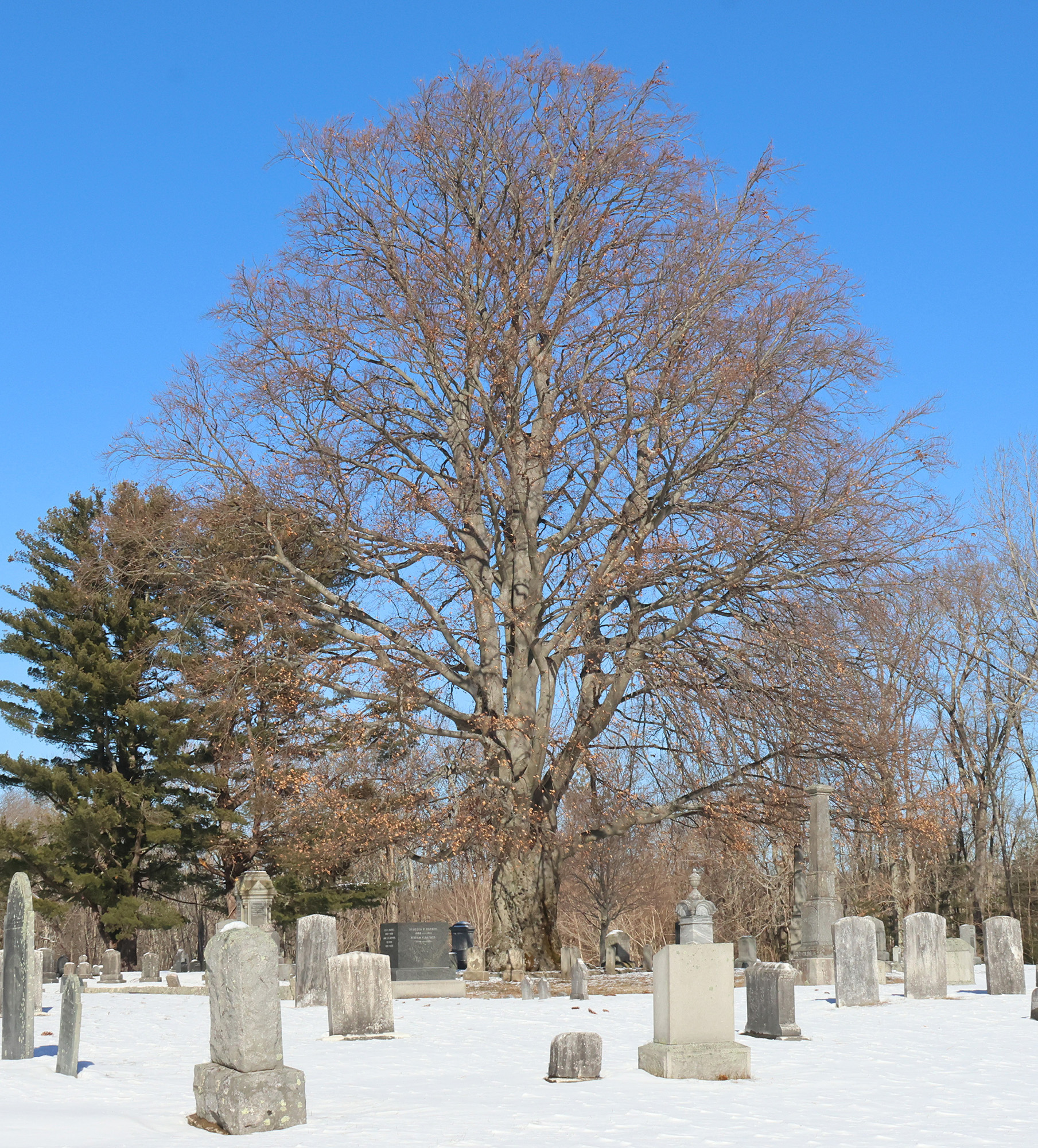
Walking in winter woods, you might spot a ghost tree from seasons past: a young beech tree decked out in pale dead leaves, all pointing down. Its persistent leaves stand out in bare gray-brown or snowy white woods. The leafy tree brings to mind summers gone by and spring to come.
Leaves of our native American beech (Fagus grandifolia) turn coppery in late fall, fade to tan, and eventually bleach almost white. Most leaves on tall mature beeches drop, but lower branches and young beech trees tend to keep their leaves through the winter. You might see that some young oaks do the same. The oak leaves are lobed, curly, and usually stay orangey brown.
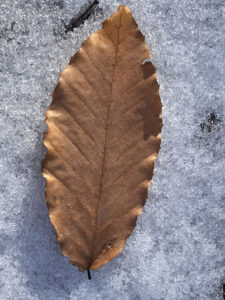
Once you notice a young American beech, look for a nearby mature beech and other young ones. Many young beeches sprout from the roots of mature trees. Eventually these saplings can become groves of genetically identical beech trees. Other young beech trees, with new genetic combinations (due to cross-pollination), grow from beechnuts that squirrels and bluejays have dropped or buried.
Note the tall, leafless American beech’s smooth, light gray bark. It remains smooth in all stages of the tree’s life – young, mature, and old. These stately, slow-growing, shade-tolerant forest trees can reach 100 feet tall and live 360 years. More typically, they get to 50-70 feet tall and 150 years old.
Resist any urge to carve initials into the smooth beech bark. It serves as the tree’s protective “skin.” As in our skin, wounds of any kind can let in infectious microorganisms, including fungi. Beech bark is very thin (about ¼ inch). It’s easily damaged by frost cracks or fire. On the plus side, the thin bark lets in enough sunlight for the trunk and branches to carry out photosynthesis, unlike trees with thicker bark. The light color of the bark also reflects some sunlight, helping to avoid overheating (and cracking) on sunny winter days.
If you see beech bark marred by coin-sized knobs and round depressions, you might be looking at a tree with beech bark scale disease. This blight is caused by a fungus (Nectria coccinea). Fungal spores are carried to the tree on tiny non-native scale insects (Cryptococcus fagisuga) that make pinpricks in the bark as they suck fluids, aphid-like, from the bark. The tree defends itself with growth that walls off infected areas, resulting in knobs and depressions. Over time, this defense may or may not succeed against the fungus.
Beech bark scale disease arrived in Halifax, Nova Scotia in 1890 on logs imported from Europe. The fungus eventually kills off large trees and infects the new ones growing from roots and nuts. In this way, the American beech is disappearing as a large forest tree and becoming a tree of the understory – like those young ghost trees you might see.
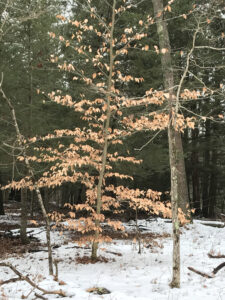
Getting back to American beech leaves: they’re 1-5 inches long, oval but ending in a point, with parallel veins and toothed edges. In summer you’ll see that American chestnut leaves look somewhat similar but are longer and skinnier (5-8 inches long), with slightly hooked teeth. You’ll find those leaves on saplings growing from roots of long-gone American chestnut trees killed by a chestnut blight.
Today, a new disease, called beach leaf disease, threatens beech trees. Green leaves develop black stripes, shrivel, and drop off. The cause is a microscopic roundworm (the nematode Litylenchus crenatae). It feeds on buds and leaves, weakening beech trees. First found in Ohio, the disease entered Massachusetts in 2020 and now exists in more than 90 towns in our state.
In winter, you’re unlikely to find beechnuts on the ground. The nutritious, triangular nuts (22 percent protein) develop in prickly husks (two or three per husk) and ripen in late September or early October. They‘re quickly gathered or eaten by wildlife: red and grey squirrels, flying squirrels, chipmunks, wild turkeys, bluejays, ruffed grouse, tufted titmice, rose-breasted grosbeaks, wood ducks, raccoons, deer, porcupines, and black bears. Beechnuts have long been part of the Native American diet.
As a native tree, American beech has evolved together with other forest life over thousands of years. Some forest residents depend on it. One example is a small rare butterfly, the early hairstreak (Erora laeta), state-listed as “threatened” in Massachusetts (https://www.mass.gov/doc/early-hairstreak/download/) . It lays its eggs on developing beechnuts.
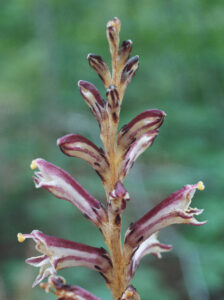
Another example is beechdrops (Epifagus virginiana, https://westboroughlandtrust.org/nn/nn129/) . Check for this small (6-20 inch) native plant under beech trees. It looks like dead twigs much of the time. It’s really a parasitic flowering plant that grows on beech roots and blooms in September or early October.
Native throughout the eastern U.S., American beeches make up about 10 percent of Massachusetts forests. Beeches actually originated in the tropics long ago. They spread north into our area about 7,000 years ago, after the most recent glaciers had retreated (15,000 years ago). American beeches often grow with other typical northern species, such as sugar maples, yellow birches, and eastern hemlocks. You’ll find all in our local woods, along with typical southern species such as oaks, hickories, and black birches. In Westborough and surrounding towns, we get to enjoy this variety in our woods, which are part of a transition area between northern and southern New England forests.
In towns and yards, look for big European beeches (Fagus sylvatica). These non-native trees were typically planted as ornamental or shade trees. They have stout trunks with typical light gray bark. European beeches are the source of popular cultivars such as copper beech.
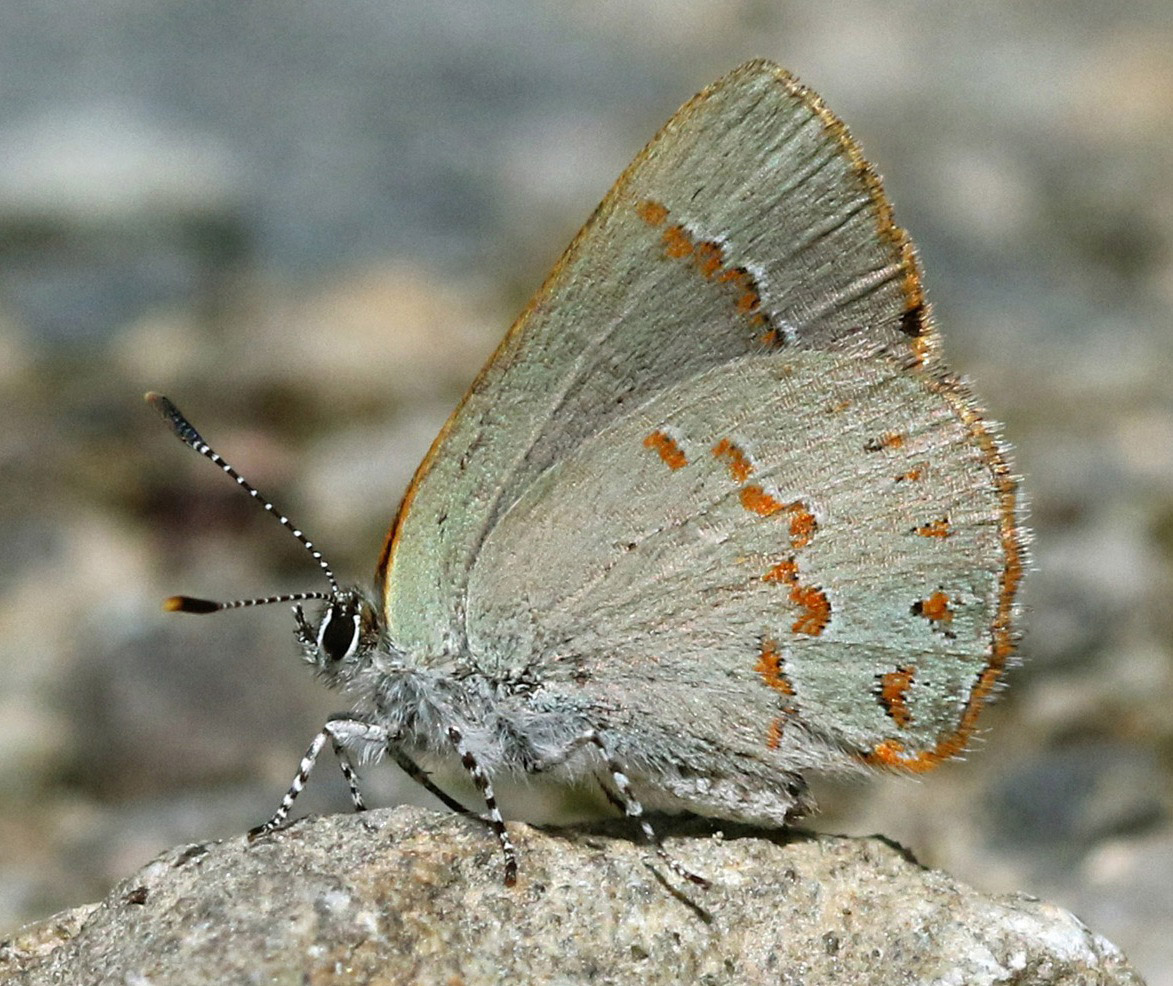
Historic European beeches exist in Westborough and other towns. Examples include Westborough’s Sanborn Historic Copper Beech (1836) on West Main Street and an estimated 250-year-old beech in Pine Grove Cemetery.
No one knows for sure why young beeches and oaks hang onto their leaves, but you – and kids – can have fun looking for them this winter. Passengers might even spot them from a car traveling back roads.
What else does nature offers in winter? Check out the articles listed in WCLT’s online monthly Nature Notes index:
https://westboroughlandtrust.org/nn/nnindex?order=month#January
https://westboroughlandtrust.org/nn/nnindex?order=month#February
https://westboroughlandtrust.org/nn/nnindex?order=month#March
Do you know that Westborough has 60 miles of trails, and WCLT has trail maps? The Westborough Community Land Trust (WCLT) preserves, protects, and promotes open space in Westborough (westboroughlandtrust.org and facebook.com/westboroughlandtrust).















